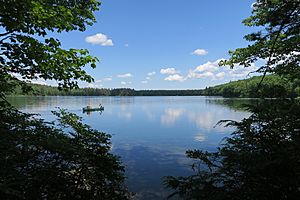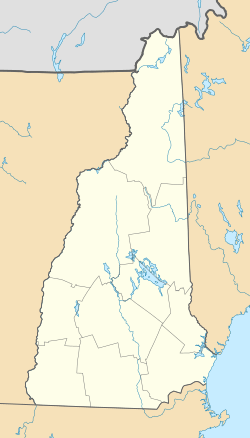Willard Pond facts for kids
Quick facts for kids Willard Pond |
|
|---|---|
 |
|
| Location | Antrim, New Hampshire |
| Coordinates | 43°01′17″N 72°00′58″W / 43.02139°N 72.01611°W |
| Type | Pond |
| Primary outflows | Willard Pond Brook |
| Basin countries | United States |
| Surface area | 108 acres (44 ha) |
| Average depth | 25 feet (7.6 m) |
| Max. depth | 58 feet (18 m) |
| Surface elevation | 1,158 feet (353 m) |
| Islands | none |
| Settlements | none |
Willard Pond is a beautiful, protected lake in Antrim, New Hampshire, USA. This special pond is located in southwestern New Hampshire. It's about 108 acres in size, which is like 80 football fields! The water is about 25 feet deep on average, but in some spots, it goes down to 58 feet.
You won't find any noisy motorboats here. Only boats without gas engines are allowed, like kayaks and canoes. Also, if you want to fish, you can only do fly fishing.
Willard Pond is part of the dePierrefeu Wildlife Sanctuary. This sanctuary is owned by the New Hampshire Audubon Society. Because the pond and the land around it are protected, there are no buildings or houses on the shore. This means you'll see lots of wild nature! The pond is surrounded by forests and trails. These trails lead you around the pond and up to the tops of Bald Mountain and Goodhue Hill. Willard Pond is a popular spot for fishing, boating, and hiking. It has become even more famous after being featured in magazines and newspapers.
Contents
History of Willard Pond Sanctuary
In 1967, a woman named Elsa Tudor dePierrefeu created the Audubon Sanctuary at Willard Pond. Elsa had a big dream for a sanctuary. She wanted it to be a safe place for all kinds of wildlife. A special rock at the entrance of the sanctuary says, "For Peace Among All Beings." This shows the peaceful vision she had for the area.
Elsa's family made the first donations to start the sanctuary. Since then, the Harris Center and New Hampshire Audubon have continued her dream. They have worked hard to protect the land. The sanctuary has grown to cover 1,400 acres. This makes it the largest piece of land owned by New Hampshire Audubon. Willard Pond itself only covers 108 acres of this huge sanctuary. New Hampshire Audubon protects over 3,000 acres of land in total. This land connects with other protected areas. Together, they form a "supersanctuary" of about 10,000 acres in New Hampshire!
Exploring Willard Pond's Geography
Willard Pond is completely inside the town of Antrim. However, to get there, you usually drive through Hancock, New Hampshire. Hancock is very close to the pond. Antrim is a small town, about 36 square miles in size. It's surrounded by other small rural towns like Hillsborough and Bennington.
You can reach Willard Pond by taking New Hampshire Route 123 through Hancock. Then, you turn onto a dirt road. The pond is at the very end of that road. The only mountain you can see from Willard Pond is Bald Mountain. It stands tall over the pond, reaching 2,083 feet high. It's called "Bald Mountain" because a fire long ago left its top without vegetation.
Just south of Willard Pond is Mill Pond. It's very small, but it's a great place to spot animals. You might see beavers and otters there. The parking lot for Willard Pond is a short walk from where you launch boats. There's also a caretaker's house between the parking lot and the pond.
Across the water from the boat launch is a spot called Pine Point. It has a small sandy beach. You'll also see large boulders in the open woods there. These huge rocks were left behind by melting glaciers a long, long time ago. You can find many of these boulders all around Willard Pond. You can reach them by hiking or by boat.
Willard Pond is part of the Merrimack River watershed. This means its water eventually flows into the Merrimack River. The pond's water flows out from its south end. This water forms Willard Pond Brook. This brook flows south for about a mile into Carpenter Marsh and Moose Brook. Moose Brook then flows southeast to Norway Pond in Hancock. From there, it flows east to the Contoocook River. The Contoocook River then flows northeast to the Merrimack River. Finally, the Merrimack River flows south, then east, all the way to the Atlantic Ocean in Newburyport, Massachusetts.
Amazing Wildlife at Willard Pond
Willard Pond is famous for its amazing wildlife. It's especially known for the common loons that build their nests right at the edge of the pond. The area where they nest is usually roped off. This helps make sure that boaters don't disturb these special birds.
Besides loons, you can find many other waterfowl (water birds) here. These include wood ducks and hooded mergansers. Many other birds can also be seen flying around. Look for bald eagles, hawks, osprey, ravens, and turkey vultures. Smaller birds like pine warblers, hermit thrushes, and white-throated sparrows also live here. Some birds stay all year, while others visit only during certain seasons.
If you hike to the top of Bald Mountain, you might hear different birds. These include yellow-rumped warblers and golden-crowned kinglets. In the forests around the pond, you can find many animals. Look for eastern chipmunks, snowshoe hares, fishers, and bobcats. You might also spot eastern coyotes, white-tailed deer, black bears, and even moose! Red squirrels and gray squirrels are also common.
The top of Bald Mountain has many red spruce trees. Around Willard Pond, you'll see a mix of oak, pine, and maple trees. Along the pond's shores, there are different shrubs. These include highbush blueberry and maple-leaved viburnum.
Fishing Fun at Willard Pond
Willard Pond is a popular place for fishing. It's known as a great "cold-water pond" for fish. This means you can catch plenty of fish here! It's considered a trout pond. The types of fish you might catch include rainbow trout, smallmouth bass, and brook trout.
Remember, only fly fishing is allowed. And no gas motors are permitted on the pond. This keeps the water calm and quiet. It's perfect for kayaks, canoes, and swimming.
Loons: Special Birds of Willard Pond
The loons at Willard Pond are very special to the people who know the pond well. There are only about 500 common loons in all of New Hampshire. This is one of the few states where these beautiful birds live. The common loon is listed as a threatened species in New Hampshire. This means their numbers are low, and they need protection.
Loons are very sensitive to air and water pollution. This is one reason why some loon groups are struggling. Willard Pond is a safe home for them. A few loons nest here every year. Boaters often see the loons diving underwater and then popping back up to the surface. The area where their nests are is roped off to protect them. Sometimes, you might even be lucky enough to see the tiny loon chicks! New Hampshire Audubon keeps a close eye on the loons. Workers often visit to count them and check on their nesting areas.
Hiking Adventures Around Willard Pond
There are many great trails near Willard Pond. These trails lead hikers up Bald Mountain and through the surrounding forests. They are well-kept and can be enjoyed in any season.
Bald Mountain Trail
This trail takes hikers up to the top of Bald Mountain. At the beginning of the trail, you can see huge glacial boulders. The trail goes partway around the pond before heading up the mountain. It's a bit steep, but the views from the top are amazing!
Tudor Trail
This trail goes halfway around the pond. It's a great place to spot beautiful wildlife along the water's edge. About halfway along this trail, you can choose to go left to the Bald Mountain Trail. Or, you can continue to the point on the opposite side of the pond where the trail ends.
Mill Pond Trail
This trail loops around Hatch Mill Pond. It connects to the Goodhue Hill Trail, which starts about halfway around the pond. Hatch Mill Pond is historic. It was once dammed to provide waterpower for the old Hatch Sawmill.
Goodhue Hill Trail
This trail leads hikers to the top of Goodhue Hill, which is next to Willard Pond. As you walk through the woods, you'll see many old stone walls. These walls were once used to separate sheep pastures long ago. You can also veer off this trail to continue on the Mill Pond trail on your way back down.



